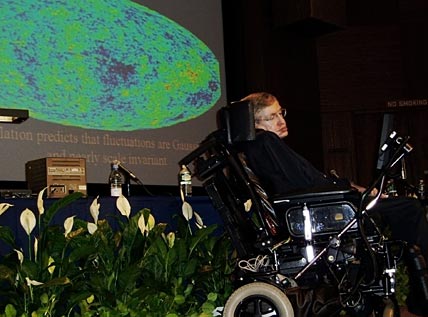
Despite decades of living with Lou Gehrig's disease, Stephen Hawking continues to present papers at conferences such as the one in Cleveland last weekend. On the screen is an all-sky map of the cosmic microwave background from the WMAP satellite.
Photo by Dan Falk.
Seventy cosmologists gathered in Cleveland last weekend to discuss the latest observations and theories about the universe as a whole, and to speculate on what the next 25 years will bring. The first Kavali-CERCA Conference on the Future of Cosmology took place at Case Western Reserve University. It drew such luminaries as Steven Weinberg, Nobel laureate and author of The First Three Minutes, and Stephen Hawking of Cambridge University, author of A Brief History of Time.
Speaker after speaker agreed that we're in a "golden age" of cosmological discovery, with many fundamental parameters of the universe — including its age, density, geometry, history, and overall composition — finally getting pinned down. Much of the best data in this regard came just this year from the spectacularly successful Wilkinson Microwave Anisotropy Probe, WMAP, which continues to map the cosmic microwave background radiation — the sky-filling "echo" of the Big Bang — better than has ever been done before.
But many mysteries remain. What is the "dark energy" that's currently giving the expansion of the universe a boost of acceleration? What caused the Big Bang itself 13.7 billion years ago? Did it originate in a "singularity," an infinitesimal point at which the laws of physics break down? Or did it spring from some larger, underlying space-time and avoid a singularity? Are there many other bangs in this underlying realm, leading to many other, different universes? Does space have 10 dimensions instead of three, as string theorists suggest? If so, where are the other seven hiding? These and other questions will keep cosmologists busy for decades, speakers agreed.

Dark energy was a hot topic. It amounts to about 73 percent of all the matter and energy in the cosmos, but its nature is completely unknown. However, astronomers are beginning to trace the history of its effects with some precision.
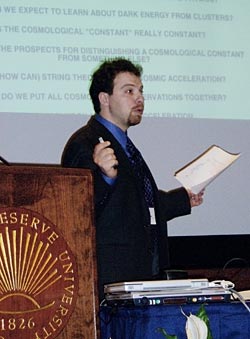
Adam Riess presenting the latest findings on dark energy from his group's measurements of supernova distances and redshifts.
Photo by Dan Falk.
Adam Riess (Space Telescope Science Institute) announced that his team has gotten a firmer fix on the time when the repulsive force of dark energy began overpowering the attractive force of gravity as galaxies spread apart from each other; this transition began the present era of cosmic acceleration. The change, he said, happened about 5 billion years ago — in line with previous, more tentative findings and nicely matching theoretical expectations. Riess's team is measuring the brightnesses of extremely distant Type 1a supernovae, "standard candles" that can be seen far across the universe, to track the history of cosmic redshifts. So is another team, led by Saul Perlmutter of the Lawrence Berkeley Laboratory in California.

Topology. Cosmologists have long wondered about the geometry of the universe — whether space is flat or curved. The last few years have brought the answer: space is flat, and seemingly infinite. But what about its "topology," or connectedness? A finite volume of flat space could give the appearance of being infinite. A two-dimensional analogy might help: in a Pac-Man game, the video screen is small, but because the right-hand side is connected to the left (making the topology identical to that of a cylinder), Pac-Man can journey endlessly in one direction, even though the space he traverses is finite.
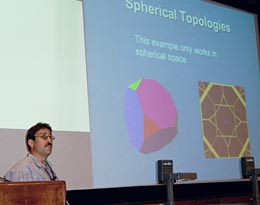
Cosmologist Glenn Starkman (Case Western Reserve University) illustrated some of the ways space could fold back on itself.
Photo by Dan Falk.
French cosmologist Jean-Pierre Luminet, US mathematician
Jeffrey Weeks, and other colleagues published a paper in the October 9th Nature suggesting that we live in a relatively small universe with the topology of a hyper-dodecahedron -- a four-dimensional analog of the three-dimensional, 12-sided structure that roughly resembles a soccer ball. Their study was based on WMAP data suggesting a puzzling lack of very-large-scale patterns in the cosmic microwave background. However, by the time of the conference other researchers had taken a closer look and ruled out many scenarios for a connected universe, including the hyper-dodecahedron. (The possibility remains that connectedness exists on a scale larger than our 13.7-billion-light-year horizon, but we can never get any evidence about this.)
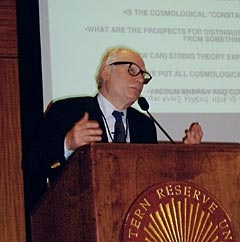
Nobel laureate Steven Weinberg believes the anthropic principle offers the only good explanation for why the 'cosmological constant' embedded in spacetime — one proposed basis for dark energy — is very small but not zero.
Photo by Dan Falk.

Anthropics. One of the conference's more heated panel discussions focused on "anthropic reasoning," the idea that our own existence provides a basis for making scientific deductions that are reachable no other way.
In its simplest form, the "anthropic principle" is uncontroversial. For instance, life requires air and water. So when scientists are born and notice their surroundings, they discover that they are on a world with air and water, rather than on a world like the Moon — even though Moonlike worlds are probably much more common in the universe.
A key anthropic controversy centers on the fundamental
constants of physics, such as the charge of the electron and the speed of light. Why do these have the particular values they do? There is no apparent reason for these values — they just "are." However, it turns out that any kind of life or organized matter — even such simple organized matter as atoms and molecules — requires many fundamental constants and laws to have special, seemingly "fine-tuned" values.
Of course, we necessarily find ourselves living in just such a fine-tuned, life-friendly universe — otherwise we wouldn't exist to be thinking about it. Does this imply that there are many other universes having many other, random values for the constants, and in most of them life never happens? Does our universe appear special merely because we are engaging in self-selection from a much larger number of universes? Does this explain the special values we measure for such things as the atomic fine-structure constant?
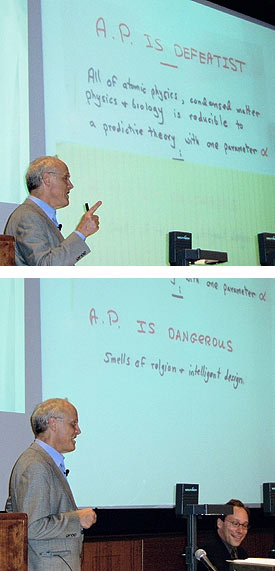
David Gross, on the other hand, considers the anthropic principle worse than useless.
Photo by Dan Falk.
The debate centered on whether such logic constitutes a scientific "explanation." To some leading physicists at the conference, such as Andrei Linde (Stanford) and Steven Weinberg (University of Texas), it does — giving us real information about the existence of larger realms we cannot observe. Weinberg applies it in particular to why Einstein's cosmological constant has a value that allows stars, planets, and life to exist. To opponents, this is quasi-religious tail-chasing and hand-waving. David Gross (University of California at Santa Barbara) described it as a disease: "Anthropic reasoning is a kind of virus," he said. "It infects people, and once infected they are lost forever."
The anthropic principle, and its growing influence on the outer shores of cosmology, will be explored in an upcoming issue of Sky & Telescope.
 0
0
Comments
You must be logged in to post a comment.